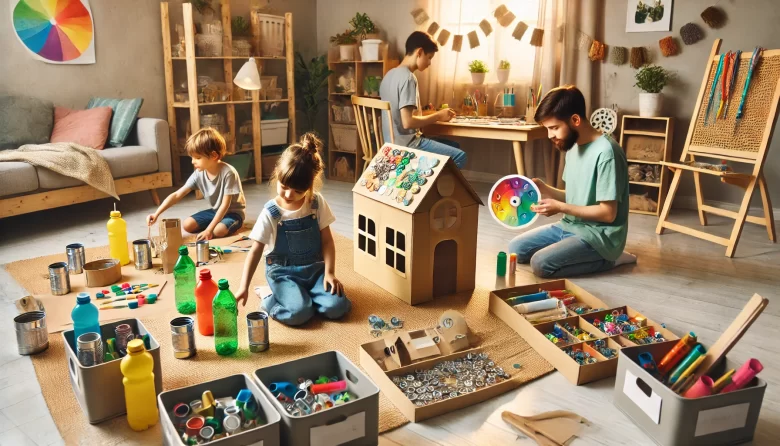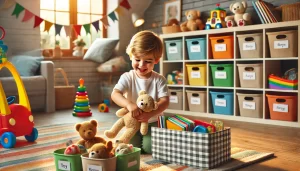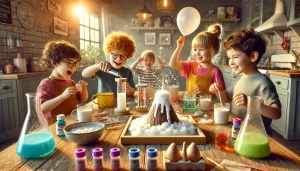Educational crafts made from recyclable materials are a fantastic way to teach children creativity, problem-solving, and sustainability. By turning household waste into fun, hands-on learning projects, kids develop essential skills while learning the importance of reusing materials.
However, to make the most of these activities, it’s essential to have a well-organized routine. A structured approach ensures that crafts are engaging, educational, and easy to set up. In this guide, we’ll explore how to create a routine for educational crafts, organize materials efficiently, and provide step-by-step ideas for creative, eco-friendly learning.
Why Educational Crafts with Recyclable Materials Matter
Using recyclable materials for crafts provides multiple benefits:
- Encourages Creativity: Children learn to see everyday objects in new ways.
- Teaches Sustainability: Reinforces the importance of reducing waste and reusing materials.
- Develops Fine Motor Skills: Cutting, gluing, and assembling materials strengthen hand-eye coordination.
- Boosts Problem-Solving Skills: Figuring out how to turn old items into new creations encourages critical thinking.
- Makes Learning Fun: Crafts can be integrated into math, science, and literacy lessons.
To make crafting a regular part of your child’s routine, organization and planning are key.
Setting Up a Routine for Educational Crafts
A well-structured routine ensures that educational crafts become an enjoyable habit rather than a stressful activity.
How to Build a Crafting Routine:
Choose a Regular Crafting Day: Pick a day or time of the week for crafting (e.g., “Recycling Craft Wednesdays”).
Set a Time Limit: Keep sessions 30-45 minutes long to maintain focus.
Gather Materials in Advance: Avoid last-minute scrambling by collecting materials throughout the week.
Have a Clear Learning Goal: Tie crafts to a theme (e.g., “This week, we’ll build animal models to learn about wildlife”).
Allow for Creativity: Provide guidance, but let kids make independent design choices.
A predictable routine makes crafting a stress-free, enjoyable experience for both children and parents.
Organizing and Storing Recyclable Materials
Keeping materials organized ensures that crafting is efficient and mess-free.
Best Ways to Organize Crafting Supplies:
Use Storage Bins: Label bins for different materials (e.g., “Paper & Cardboard,” “Plastic Bottles,” “Fabric Scraps”).
Rotate Materials: Keep a selection of frequently used materials and recycle the rest to avoid clutter.
Create a Crafting Station: A designated area with scissors, glue, and markers makes crafting more accessible.
♻ Involve Kids in Sorting: Teach them to separate materials properly—turning organization into a learning opportunity.
An organized space helps children take ownership of their creative projects.
Educational Craft Ideas Using Recyclable Materials
Now that we have a solid routine and organized materials, let’s explore some educational craft projects.
DIY Alphabet and Number Learning Board (Using Cardboard & Bottle Caps)
Best for: Early literacy and numeracy skills
Materials Needed:
- Cardboard box (as the base)
- Bottle caps (one for each letter or number)
- Markers or stickers
- Glue
How to Make It:
- Write letters or numbers on bottle caps.
- Draw letter/number outlines on the cardboard.
- Have your child match the caps to the correct outlines.
This interactive board reinforces letter and number recognition in a fun, hands-on way.
Recycled Superhero Masks (Using Cereal Boxes & Fabric Scraps)
Best for: Imaginative play and fine motor skills
Materials Needed:
- Empty cereal boxes
- Fabric scraps or colored paper
- Scissors and glue
- Elastic string
How to Make It:
- Cut out a mask shape from the cereal box.
- Let your child decorate it with fabric or paper.
- Attach an elastic string so they can wear it.
This project combines creativity with pretend play, encouraging storytelling skills.
DIY Mini Greenhouse (Using Plastic Bottles)
Best for: Teaching science and sustainability
Materials Needed:
- A large plastic bottle
- Soil and seeds
- Water spray bottle
How to Make It:
- Cut the bottom of the plastic bottle and fill it with soil.
- Plant seeds and water them lightly.
- Cover with the top part of the bottle to create a mini greenhouse.
This craft teaches children about plant growth and the environment.
DIY Puppet Theater (Using a Shoebox & Fabric Scraps)
Best for: Language skills and storytelling
Materials Needed:
- A shoebox
- Old socks or felt for puppets
- Paint, glue, and decorations
How to Make It:
- Cut out a “stage” window in the shoebox.
- Decorate the box as a theater.
- Use socks or felt to make puppets.
Children can put on puppet shows, enhancing their communication skills.
Tips to Keep Kids Engaged in Crafting
Sometimes, kids lose interest quickly. Here’s how to keep them engaged:
Make Crafts Relatable: Connect projects to their favorite stories, characters, or interests.
Turn It into a Challenge: Example: “Can you make an animal only using toilet paper rolls?”
Incorporate Storytelling: Let them narrate their craft’s “adventure” (e.g., “This cardboard spaceship is flying to Mars!”).
Mix Crafts with Science: Experiment with light refraction using plastic bottle prisms or build a cardboard marble run to explore physics.
A fun, interactive approach keeps children eager to explore new crafting ideas.
Teaching Responsibility Through Cleanup and Recycling
Crafting is fun, but cleaning up is equally important. Teach children to be responsible for their workspace.
Ways to Make Cleanup Part of the Routine:
Sort Leftover Materials: Encourage them to put reusable items back in storage.
Recycle Properly: Teach which materials belong in the recycling bin.
Make Cleanup Fun: Play a song and challenge them to tidy up before it ends.
By including cleanup in the routine, kids learn responsibility while maintaining a sustainable crafting habit.
How to Integrate Crafts into Other Subjects
Best for: Making learning multidisciplinary and engaging
Educational crafts don’t have to be separate from other subjects. They can be a fantastic way to reinforce learning in different areas.
Ways to Integrate Crafts with Other Subjects:
Literacy: After reading a story, children can create puppets or dioramas to retell the tale.
Math: Use bottle caps to make a counting board or create a shape-sorting game with cardboard.
Science: Build a homemade volcano or a water cycle model with recyclable materials.
History & Culture: Make cultural masks, flags, or monuments from different countries using paper and recycled items.
By combining crafts with academic subjects, children retain information better and develop a deeper understanding of concepts.
Encouraging Group Collaboration with Recycled Crafts
Best for: Teaching teamwork, patience, and communication
Crafting doesn’t have to be a solo activity! Collaborative projects teach children important social skills such as sharing, cooperation, and problem-solving.
Fun Group Craft Ideas:
Recycled Robot Challenge: Each child contributes a different recycled material to build a giant robot together.
Cardboard City: Have kids create buildings, roads, and vehicles out of boxes and paper rolls.
Community Storyboard: Each child makes one part of a larger craft (e.g., different animals for a jungle scene).
Working on crafts together helps children practice listening, taking turns, and valuing each other’s contributions.
Hosting a “Recycled Craft Exhibition” at Home
Best for: Boosting confidence and showcasing creativity
A great way to celebrate your child’s creativity is by setting up a small craft exhibition at home.
How to Organize a Mini Craft Show:
Pick a Date: Plan a day where family members can attend the “exhibition.”
Display the Crafts: Use shelves, tables, or walls to show off the creations.
Let Kids Present Their Work: Encourage them to explain their crafts and the materials used.
Give Small Awards: Fun categories like “Most Creative” or “Best Use of Recycled Materials.”
This experience helps boost confidence, strengthens public speaking skills, and makes children feel proud of their efforts.
Expanding Learning with Digital and Interactive Elements
Best for: Combining hands-on creativity with technology
Technology can enhance the crafting experience in exciting ways.
Ideas for Mixing Crafts with Digital Learning:
Take Photos and Create a Digital Craft Book: Document projects with pictures and write short descriptions.
Make Stop-Motion Animations: Use a phone or tablet to create a simple stop-motion video with their crafts.
Explore Recycling Documentaries: Show age-appropriate videos about recycling to inspire new project ideas.
Use Online Templates for Crafting Inspiration: Websites with printable templates can help guide projects.
Integrating digital tools can deepen children’s engagement while teaching them about technology in a creative way.
Long-Term Craft Projects for Extended Learning
Best for: Teaching patience, planning, and persistence
Most crafts are short projects, but long-term crafting teaches children how to plan, stay committed, and see progress over time.
Ideas for Ongoing Craft Projects:
Recycled Garden: Use plastic bottles, milk cartons, or egg cartons as planters and track plant growth over time.
Build a Cardboard Dollhouse: Construct and decorate a dollhouse using leftover cardboard, adding rooms gradually.
DIY Train Set: Start with one train car made from a box, then add more pieces over time.
Seasonal Crafts: Create decorations for different holidays throughout the year using recyclable materials.
These projects reinforce patience, critical thinking, and responsibility while allowing children to work on something meaningful over time.
Final Thoughts
Educational crafts using recyclable materials provide a unique opportunity for children to develop creativity, sustainability awareness, and problem-solving skills. By setting up a structured routine, organizing materials efficiently, and introducing fun projects, you make crafting an enjoyable and meaningful part of your child’s learning experience.
Start your first recycled craft project today and watch your child’s imagination soar while learning valuable lessons about the world around them! 🌍✨




